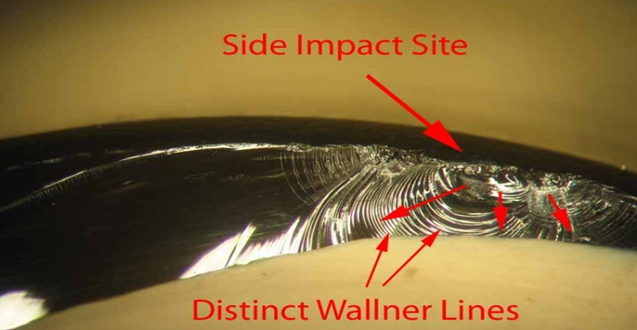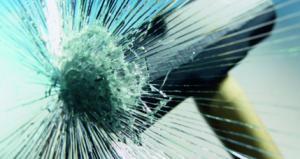What is glass?

In general, glass is a hard and brittle substance that is usually transparent or translucent. It may be comprised of a fusion of sand, soda, lime, or other materials. The most common glass forming process heats the raw materials until they become molten liquid, then rapidly cools the material to create hardened glass. Glass is also called a “solid liquid”: the structure of glass is only partially crystalline – its crystals are irregular in shape, like water in the ice state. Glass does not have a strictly defined freezing point either – its crystals can start migrating towards each other even before the melting point is reached.
Scientists are still debating whether glass is really a supercold liquid or a crystal. Glass occupies an intermediate position between these two states.
Everyone knows that glass can break. If this does happen, it is important to understand the origin of glass breakage and learn best practices for identifying causes and finding solutions.
The glass breakage

Locating the origin
 Like any good detective, it pays to ask questions about the breakage. Knowledge of activities taking place in or near to the glass, any recent unusual events, or changes, and remedial or maintenance work on site can all give a clue as to what may have occurred. All photos are valuable, not only of the split, but also of the window, the wall where it is installed or the entire building, and the surrounding environment.
Like any good detective, it pays to ask questions about the breakage. Knowledge of activities taking place in or near to the glass, any recent unusual events, or changes, and remedial or maintenance work on site can all give a clue as to what may have occurred. All photos are valuable, not only of the split, but also of the window, the wall where it is installed or the entire building, and the surrounding environment.
Locating the origin of the breakage is also vital, as it will contain crucial evidence. It’s almost the equivalent of finding a fingerprint at the scene of the crime! The glass should be examined from both its surface and its edge to gather as many clues as possible.
A magnifying glass is essential for examining the glass, both on the surface and looking through the edge. Determining the origin of the fracture requires determining the trajectory and pattern of the breakage.
 Inspection of the impact site
Inspection of the impact site
Already on the surface of the glass, you can sometimes find the source of the breakage by determining the branching point – you can see like „a sun with rays“, the center of which is the reference point. Watch for the most concentrated areas of damage, as they are a sign of origin. Inspection of the area of the glass break, branch marks and crack lines should also help determine the origin of the break.


Fractography is a method in failure analysis for studying the fracture surface of materials. Such damage analysis, which can be performed both macroscopically and microscopically, can often and accurately determine the origin or cause of the breakage and the direction of crack splitting. The most important fractographic properties of glass are the start of the damage, which marks the origin of the breakage and provides information about the stress causing the impact, and the „Wallner“ lines, which clearly show the direction of the crack splitting.

There are three rules for glass breakage:
1. Cracks always branch only in the direction of their spreading.
If these branches are followed back, one comes to the center of the original crack beginning.
2. A crack can never jump over an existing crack. The crack ends when the next crack is reached. Due to this fact, it is often possible to determine the sequence of their occurrence and the location/cause of the initial crack.
3. The average number of cracks depends on the degree of load at the time of cracking.
Generally, a denser network of cracks is formed when the glass is subjected to a higher cracking load than vice versa.
If the glass that has broken is to much, then the glass detective may be unfortunate in finding that most of the fragments have fallen from the frame and ended up on the floor. There, it’s a case of getting down on your hands and knees to search for the fragments containing the origin.
Causes of glass breakage

Glass breakage can be caused by a number of factors, including impact, pre-installation edge damage, poor installation, structural deformation, unusual design, nickel sulfide (NiS) impurities in the glass, and thermal cracking.
Most often, it is possible to determine the reason of crack by the view of broken glass. Though, there are cases, when it is hard to do. If possible, we always recommend performing glazing bead opening act and inspection of the insulating glass unit. When observing the crack, start with by assigning of the view of the broken glass to a certain group of breaks/cracks: mechanical or thermal.
Some glass breaks are easier to detect than others. For example, thermal cracks usually run from the edge of the glass and are perpendicular to it. Others may be more difficult to identify without the use of crack identification descriptions and images or laboratory microscopy and may require subsequent chemical analysis if nickel sulphide (NiS) impurities are suspected.
So with a bit of experience we can all become a ”glass detective”, helping to identify the likely cause of glass breakage, which can play an important role in resolving supply chain disputes and negotiating solutions. You can find more about the types and descriptions of glass breakage in GlassLT Technological Regulation Appendix no. 2 https://glasslt.com/wp-content/uploads/2023/02/Priedas-Nr.-2-EN-Versija-Nr.-7-3.pdf (pages 29-36).
Types of glass and how different glasses break:



Annealed glass (A) Laminated glass (B) Thoughened glass (C)
| No. | Type of parameter | Classification | Remarks |
| 1 | Pendulum body impact resistance | 3, 2, 1 | Where resistance class 3 is the lowest, class 1 – the highest. |
| 2 | Mode of breakage | A | Numerous cracks appear forming separate fragments with sharp edges, some of which are large. This type of breakage is typical of annealed glass. |
| B | Numerous cracks appear, but the fragments hold together and do not separate. This type of breakage is typical for laminated, film applied glass and wired glasses. | ||
| C | Disintegration occurs, leading to a large number of small particles that are relatively harmless. This type of breakage is typical for thermally toughened glass. |

